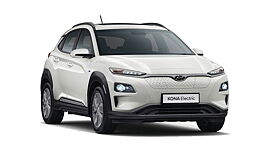What is it?

It is what the Prius is to Toyota and the Leaf is to Nissan. While not really a trend starter like the other two, but it is still a significant car for Hyundai.
If you like how the Hyundai Elantra looks, you will love the Ioniq. Dimensionally its quite similar to the Elantra as well. The silhouette is more notch-back and that does give it a sporty stance. Giveaways of it being electric besides it passing you by silently is an all silver front panel which replaces the grille. The Ioniq has recently been updated in Korea and now gets cooler looking headlamps and a redesigned bumper among other things. Then, of course, there are the flat-ish alloy wheels for better aerodynamics. Overall, the Ioniq is a good looking car that won’t raise any eyebrows but won’t be disliked either.

How is it on the inside?
After the Nexo and the Kona, the Ioniq's interiors feel a tad dull, however, there is no mistaking the Ioniq as anything else but a Hyundai. The steering wheel and the buttons feel quite familiar and while it's not the classiest cabin we have experienced, it’s certainly very ergonomic and loaded with features.

The front seats are pretty comfy for most frames and you can get into a comfortable position in no time at all. The rear, however, isn’t the most spacious. Headroom is also little compromised thanks to the sloping roofline but will affect you only if you are over six-feet tall.
A 10.25-inch infotainment screen takes centre stage with all the connectivity options and you also get automatic headlights, automatic temperature control, heated front seats, a tilt and telescopic steering wheel, cruise control, keyless entry and push-button start, power sunroof, power driver’s seat adjustment with memory function, an auto-dimming mirror, and a wireless charging pad.
How does it drive?

Powering the Ioniq EV is a 135bhp electric motor which gets its juice from a 38 kWh lithium-ion polymer battery pack. In the short drive that we did, the Ioniq felt brisk. Driving it around the busy town of Seoul was an absolute joy. The single speed automatic transmission feels like a CVT. The steering feels quick to turn in and maneuvering through city traffic is easy as pie. The range though at 311 km is on the shorter side especially when you compare it to the 400 plus km range of the Hyundai Kona.
Ride quality is extremely compliant too with Hyundai focusing hard on comfort. Also something that Hyundai has managed to get right are the brakes. With regenerative braking thrown in, brake feel on most EVs tend to feel wooden but that's not the case in the Ioniq.

Can I buy one?

Unfortunately no. While we are getting the Kona, the Ioniq is still some time away. Overall the Ioniq is a comfy, feature loaded car for the urban confines. It is, in fact, Hyundai’s first electric effort and whatever progress the company has made rests on the Ioniq’s shoulders. We hope Hyundai gives it the Kona’s range and brings it to India in the future.

























